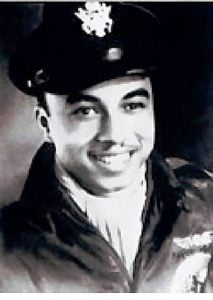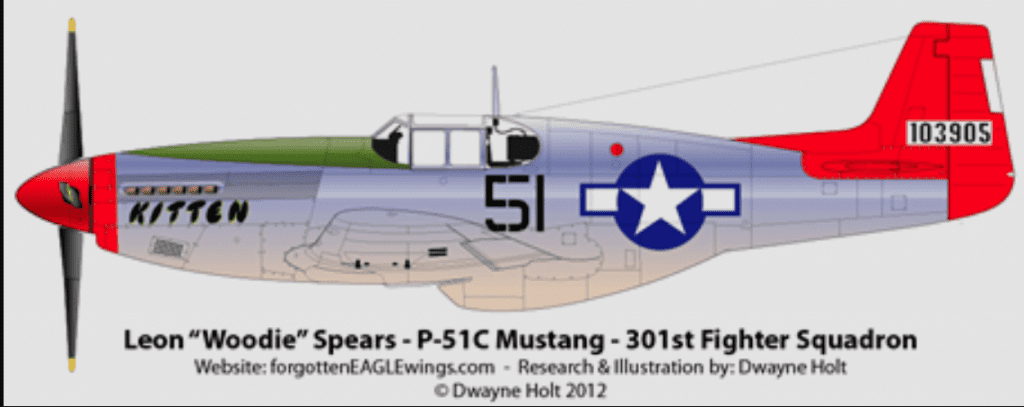 2Lt Leon ‘Woodie’ Spears
2Lt Leon ‘Woodie’ Spears
Class 44-F-SE
January 15, 1924 – May 12, 2008
Unit 301st Fighter Squadron, 332nd Fighter Group.
Leon ‘Woodie” Spears was born in Colorado in 1924. Spears grew up around planes. In a speech, he recalled hearing the drone of planes at the Pueblo Municipal Airport, next door to his family’s Colorado home.
“I thought, right then and there, ‘My God. I don’t care what happens, that’s what I’m going to do. I’ve got to fly.’ ”
When World War II started, Spears tried to join the Army Air Corps, but was turned away.
“My white and Hispanic friends went down to the recruiter and he said, ‘You all can join except for you,’ and he pointed at me,” Spears said in a 2008 interview with the Journal Sentinel in Milwaukee. “He said, ‘We have no provisions for training colored people.’ ”
“I found out through what we called the ‘colored newspapers’ that a lawsuit had been filed to open things up for us. I found a copy of Life magazine and on the front was the picture of five black guys from Tuskegee. I went back to that recruiter and showed him a copy of that magazine and to his credit he said, ‘I’ll look into it for you.’ ”
He earned his wings on June 27, 1944, with the class of 44F at Tuskegee, Alabama. He was an original “Red Tail” serving with the 301st Fighter Squadron, 332nd Fighter Group. Spears graduated from flight training on June 27, 1944, at Tuskegee Army Air Field in Alabama. He deployed to Italy with the 301st Fighter Squadron and completed 50 missions, first in a P-51 Mustang nicknamed “Donna” until it was destroyed in a landing accident, then in a P-51 that Lt. Charles McGee had named “Kitten”, which was his nickname for his wife Francis.

*NOTE: When the 302nd Fighter Squadron was disbanded; all the aircraft went to the remaining squadrons. Kitten was picked up by Mr. Spears at a sub-depot station. The aircraft squadron markings were revised and a new “buzz” number was assigned. During an interview with the Air Classic magazine in 1999 Spears said “I flew this P-51C around the end of 1944. I was assigned to the 301st Fighter Squadron from the 302nd Fighter Squadron, so I had to pick up my new plane from the sub-depot station in either North Africa or Southern Italy. When I saw the plane, I noticed it had the name “KITTEN” on the side of the nose. I believed this plane originally belonged to Charles McGee of the 302nd Fighter Squadron. I believe I know why he called it “KITTEN”, because the engines sure “purred” like one when I fired it up. I remember this plane well because I had a number “51” on the side of the plane, my plane was a P-51 with “51” on the side.”
Spears was flying “Kitten” — his 51st mission — when he came under attack on March 24, 1945.
The Fifteenth Air Force launched its longest mission that day: A 1,600-mile round trip mission to a tank assembly plant in Berlin, Germany. Pilots from the 332nd Fighter Group escorted bombers to support the mission, leaving Ramitelli Air Field in Italy at 11:45 a.m. The fighter pilots who were scheduled to relieve the 332nd at the outskirts of Berlin were late, so the group continued toward the target. As they neared the capital, 25 enemy fighters attacked the American bombers. The 332nd fought back, and by the end of the day they had destroyed three enemy planes and would earn a Distinguished Unit Citation. But 30 minutes after leaving the base in Italy, flak blew off the outer right wing of Spears’ plane.
“I was hit by German 88 guns during a mission over Berlin at 32.000 feet. That’s almost six miles straight up! There was no way I could get back to Italy and make it over the Alps, so I had to crash land “Kitten” in Poland. I would have to be at least 18.000 feet to cross the mountains. I knew by the way my engine was sounding that I would be no way near 18.000 feet to make it home.
I turned 90 degrees west toward Poland and I landed near this river. The Germans were on one side of the river and the Russians were on the other side. Between the two of them, they shot my plane to pieces. You see, when the P-51 Mustang is flying directly at you it looks like an Me-109 from certain angles. While I was flying down this river I could feel shells hitting the plane. I said to myself, well, I’m on this side of the river so the shells got to be coming from those Russians. Once they saw that I was an American they stopped firing at me. As I remember, I saw myself coming toward this runway. I said to myself that if I let the wheels down I could probably make a pretty good landing. I decided not to land because I did not want the enemy to use the plane. As I was in the process of putting the wheels up I hit the ground. I did not have enough power to work the hydraulics.
Surprisingly, it was Germans that came right away in a car. There were two officers and three enlisted men in Nazi helmets and they had their guns pointed right at me. I put my hands in the air and they motioned for me to come close. They could see that I had a .45 pistol. They made motions that they wanted that .45 on the ground, which I did. It seems to me that they were trying to be as nice as they could because they knew that the war was coming to an end for them, so they did not want to get too cruel. The Germans did know about the Geneva Convention which dealt with war crimes. They did not want to be involved in any war crimes. They sat me in the car and drove to their headquarters. I was interrogated by a German official who asked if could speak English. He asked me where did I come from. I told him. “I’m sorry, I can’t tell you. I can tell you my name. rank and serial number.” I said, “You know the Geneva Convention, don’t you? He said, “Yes”, whenever he would ask me something. I would mention the Geneva Convention then he would say, “I’m sorry I ask,” and that was it. They knew full well that any information they could get would be useless for them. I was only with them for three days.
The Russians were in Poland and they were advancing about 25 to 35 miles a day. At about the third day I heard all this ripping and roaring, and the building was shaking and everything. All the glass was out of the windows, but I pulled a board off a window area and the first thing I saw was this huge Russian tank. There were 40 or 50 guys surrounding it going through the town blowing up buildings. This scared me because I thought that they would blow this building up that I was in. I was screaming and hollering to them and a guy that looked like a Russian officer looked up and saw me. When I saw him looking at me, I had an A-2 flight jacket on with a large American flag on the back. I put my back to the window so he could see it and I could hear him yell. “American! American!” He came up and gave me a big bear hug!

Spears returned to the 301st Fighter Squadron on May 10.
Spears remained in the Army after World War II, flying 17 combat missions in the Korean War, which started in 1950. On a reconnaissance flight, Spears’ younger brother, a pilot who was serving under Spears for one day, was killed by anti-aircraft fire.
“It just devastated Woodie,” said Phil Schasker, public affairs officer for the San Francisco Bay Area chapter of the Tuskegee Airmen Inc., in a 2008 interview with the San Francisco Chronicle. “For that reason, he returned to the United States.”
Spears retired as a captain, and worked for the U.S. Postal Service for 35 years. He toured the country, stopping at schools to share stories about the Tuskegee Airmen.
“There is nothing that is more rewarding, especially with youngsters,” Spears said of his tours. “These kids, they might be little rockets and what-not, but when I start in, they’re on the edge of their seats and ask some very cogent questions. Some of the things they ask kind of keep me on my toes. Nobody loves what he does as much as I do.”
Watch this video of Woodie Spears speak of his experiences as a Tuskegee Airman.
Sources:
Findagrave.com
Saint Louis Dispatch
Wings Of History Air Museum





